It uses less power and gives more bright.
There are many type LEDs like normal, high power, RGB, SMD.
Each type are used in different place like TV, torch, display and decoration.
Today LED is very important in human life.
Working Principle of LEDs:
LED work on semiconductor principle.
Inside LED there are two part: P-type (positive) and N-type (negative).
When electricity flow the electron from N-side meet hole from P-side.
This meeting release energy as photon light.
Light color like red, green, blue, white depend on material use.
Other things in working:
Forward Bias: LED work only when current goes forward.
Low Heat: LED make very less heat than normal bulb.
Efficiency: More power become light with less waste.
Brightness Control: Brightness change by more or less current or by PWM.
Different Types of LEDs:
Through-Hole LEDs:
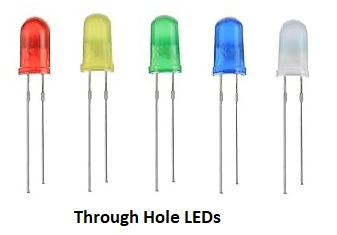
Common LEDs have two leads for circuit boards.
Come in sizes 3mm, 5mm, 10mm.
They are simple indicators in machines, toys, student projects, small circuits and in power ON/OFF lights.
Surface Mount LEDs (SMD LEDs):
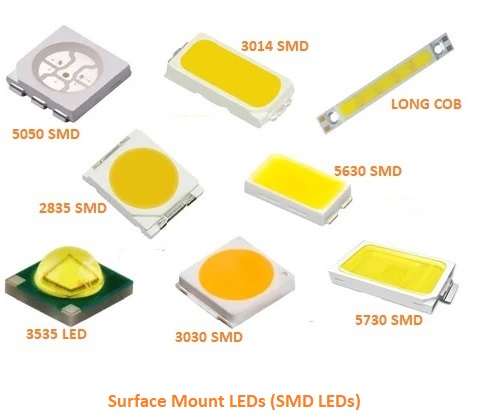
SMD LEDs mount directly on PCB.
They are small, bright and very efficient.
The LED strips are used for decoration, flat panel displays, TV and mobile screens, automotive dashboards, traffic lights.
High Power LEDs:

High Power LEDs handle high current and give strong light.
They need good cooling like heat sinks.
These types of LED is used where very strong light is needed like in flashlights, car headlights, stage lighting, flood lights, emergency lamps.
RGB LEDs:
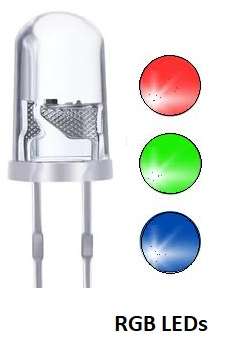
RGB LEDs have red, green and blue chips in one package.
Changing each colors brightness makes many colors.
They are used in decorative color-changing lights, advertising boards, disco lights, LED TVs, smart bulbs for mood lighting, festival lights.
Infrared (IR) LEDs:
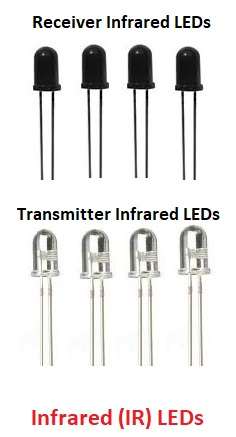
IR LEDs give light which we human can not see.
Infrared IR LED are used in TV and AC remote control, CCTV night vision, automatic door sensors, line-following robots, biometric systems.
Ultraviolet (UV) LEDs:
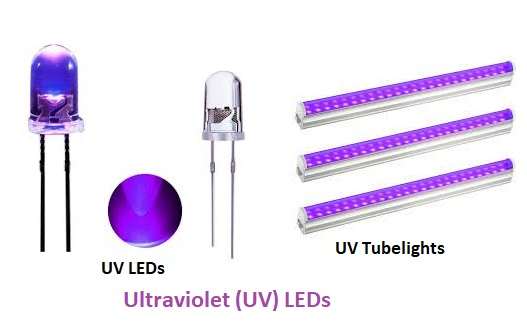
UV LEDs give ultraviolet light.
They are used for sterilizing water and air, curing dental fillings, money checking machines, nail polish drying, forensic crime investigation.
Organic LEDs (OLEDs):
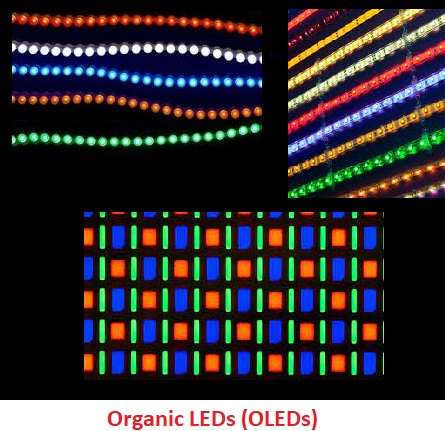
OLEDs use organic semiconductors to make light.
They are flexible and show true colors with high contrast.
They are used in premium mobile phone displays, smart TV panels, smartwatch screens, flexible electronic newspapers, transparent displays.
Micro LEDs:
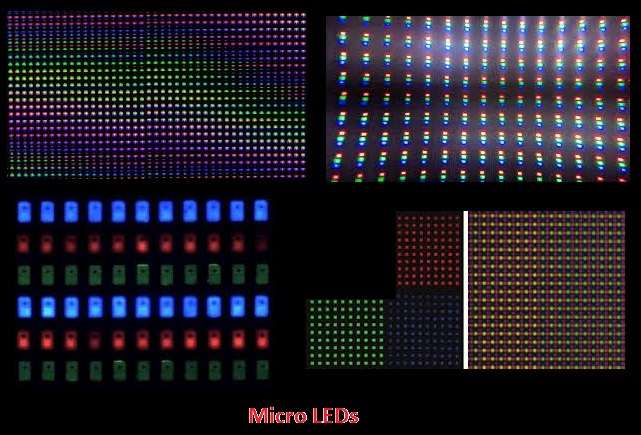
Micro LEDs are tiny LEDs with high brightness and efficiency.
They are used in high quality AR and VR glasses, next generation TV, smartwatch and large digital billboards with high resolution.
COB (Chip on Board) LEDs:
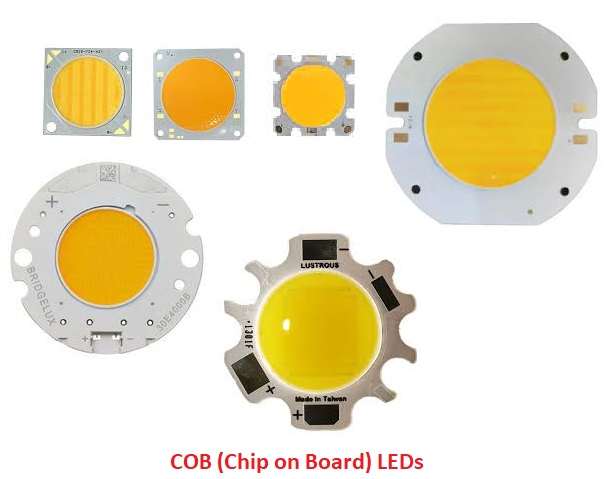
COB LEDs have many chips in one module by making them very bright.
They are used in ceiling spotlights, industrial workshop lamps, stage lights, downlights for homes, flood lights for stadiums.
Features and Functions of LEDs:
1. Through-Hole LEDs:
- It have two long pins means legs
- Easy to connect in breadboard or circuit
- Available in many colors
- Low cost and in simple design
- Strong body and is not very fragile
2. Surface Mount LEDs (SMD LEDs):
- Very small and comes in flat size
- No long pins but it is directly mounted on PCB
- Can fit in many small area
- More brightness than through-hole LED
- Used in strips and displays
3. High Power LEDs:
- Very bright and produce strong light
- Need heat sink for cooling
- Can run on higher current
- Long life with proper cooling
- It is used for powerful lighting
4. RGB LEDs:
- Have three colors inside it like Red, Green and Blue
- Can make millions of colors by mixing
- Controlled by microcontroller or driver
- Bright and attractive
- Used for decoration and displays
5. Infrared (IR) LEDs:
- Emit invisible light which we cannot see by eye
- Low power consumption
- Work with sensors and cameras
- Can transmit signals over distance
- Safe and reliable
6. Ultraviolet (UV) LEDs:
- Emit UV light which is not fully visible
- Can kill germs and bacteria
- Special material are used to make
- Handle with care as too much UV is harmful
- Used for sterilization and detection
7. Organic LEDs (OLEDs):
- Made with thin organic material films
- Very thin and light weight
- Can be flexible or bendable
- High brightness and sharp contrast
- Better color quality than normal LED
8. Micro LEDs:
- They come in extremely small size LED
- High brightness even in sunlight
- Very low power use
- Very long lifespan
- Can make very high-resolution display
9. COB (Chip on Board) LEDs:
- Many LED chips are packed together on one board
- Similar and smooth light output
- Less glare, wide beam angle
- Very efficient with more light per watt.
Extra Information:
1. General Advantages of LEDs:
- Use less power compared to old bulbs with energy saving.
- Very long life and can work 25,000 to 50,000 hours.
- Come in small in size but gives bright light.
- Available in many colors without filters.
- Produce less heat and is safe to use.
- Environment friendly with no mercury like CFL.
2. Limitations of LEDs:
- Cost more than normal bulbs but saving in long run.
- Some types need extra cooling like high power LEDs.
- Sensitive to wrong voltage and current or else it can burn.
- Light beam angle sometimes narrow, need lens and different user.
3. Applications of LEDs:
Household: Lamps, tube lights, decorative lights.
Automotive: Car headlights, dashboard lights, indicators.
Electronics: Remote control, sensors, displays.
Medical: UV LEDs for sterilization, IR LEDs for therapy.
Industrial: Street lights, flood lights, factory lighting.
Displays: TVs, smartphones, advertising boards, wearables.
4. Future of LEDs:
- Micro LEDs and OLEDs are future for display technology like TV, VR and phones.
- Smart LEDs connected with IoT for smart homes.
- More eco-friendly lighting are replacing traditional bulbs fully.
- Development of flexible and transparent LEDs for new devices.
5. Safety Notes:
- IR and UV LEDs are not visible but they can still be strong so we must use is carefully.
- High power LEDs can heat up, so cooling is needed.
- Direct looking into bright LED for long time can hurt eyes.
Conclusion:
In this post for Different Types of LEDs: A Comprehensive Guide LEDs come in many different types.
Some are simple like through-hole LEDs and some are powerful like high power LEDs and some are advanced like OLEDs and Micro LEDs.
Each type has own special use in our daily life.
From remote control to street light and from phone screen to smart home, LEDs are everywhere.
They save energy and give bright light and help technology move forward.
Leave a Reply